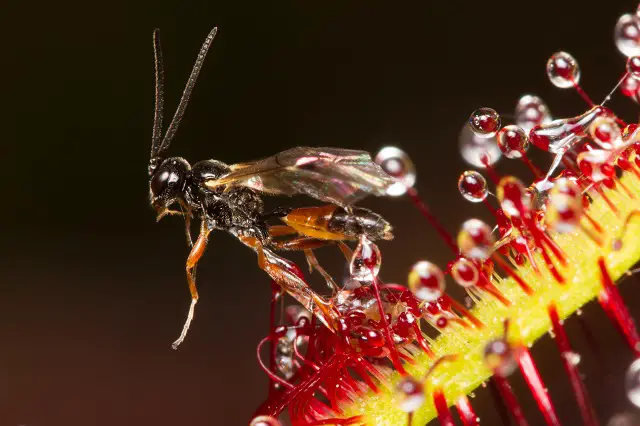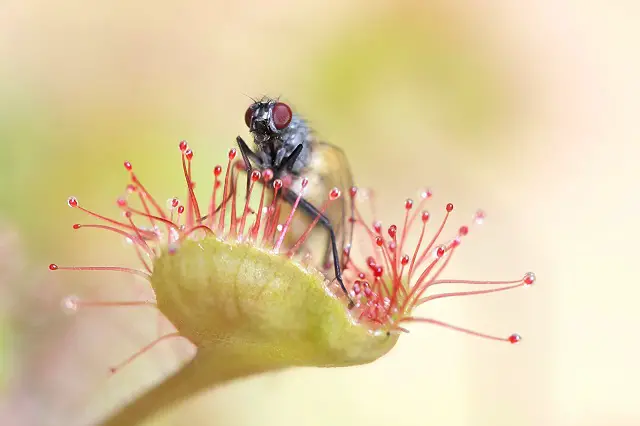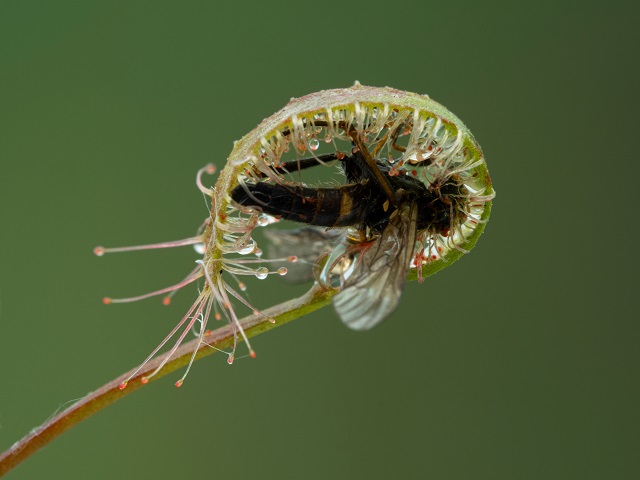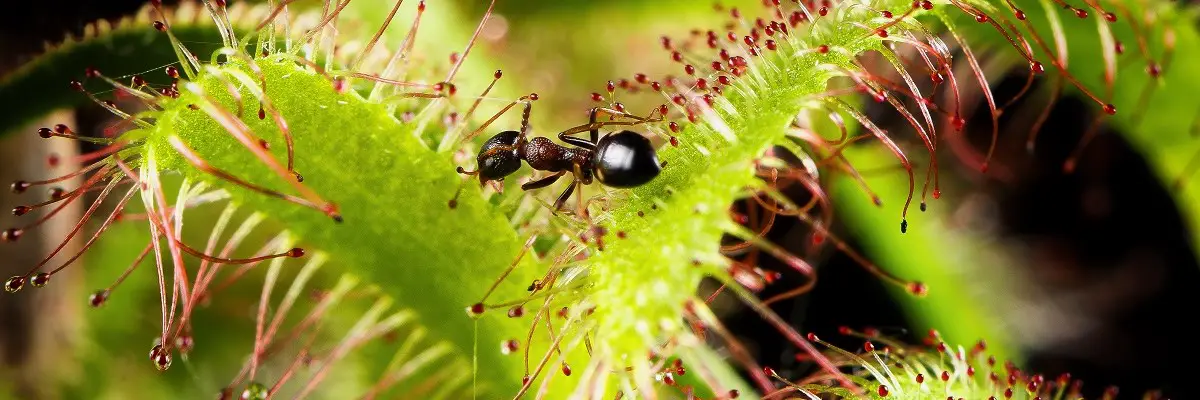The average time it takes for a sundew to eat a bug varies depending on several factors. The size of the bug, the type of prey, the species of sundew and its trap size, as well as environmental conditions all play a role in determining how long it takes for a sundew to eat a bug. On average, it can take anywhere from several hours to several days for a sundew to fully digest and absorb its prey. However, it is important to note that this is just an estimate, and actual times may vary greatly based on the circumstances. In some cases, a sundew may be able to capture and consume a bug within just a few minutes, while in others, it may take several days for the process to be completed. Ultimately, the specific time it takes for a sundew to eat a bug will depend on a complex interplay of biological, environmental, and ecological factors, making it difficult to predict with certainty.
What is a Sundew?
A sundew (Drosera) is a carnivorous plant known for its unique way of catching its prey. Sundews are found in a variety of habitats, ranging from bogs and fens to tropical rainforests. They are characterized by their brightly colored leaves that are covered in sticky, glandular hairs. These hairs secrete a sweet, sticky nectar that attracts a wide range of small insects, including ants, flies, and mosquitoes. When an insect lands on the leaves of a sundew, it becomes trapped in the sticky nectar, allowing the plant to close its leaves and digest its prey slowly. This hunting strategy allows sundews to obtain essential nutrients and minerals that are otherwise lacking in their nutrient-poor environments. There are over 170 species of sundews, each with its own unique characteristics and adaptations that allow it to thrive in its specific environment.

Factors that affect the time it takes for a Sundew to eat a bug.
Type of prey
The type of prey that a sundew will target and consume depends on several factors, including the size and location of the sundew and the availability of insects in its environment. Some common types of prey for sundews include:
- Flies: These is one of the most common types of insects that are attracted to sundews. Flies are attracted to the sweet nectar that is secreted by the sticky hairs on the sundew’s leaves.
- Mosquitoes: Some species of sundews are specially adapted to attracting and consuming mosquitoes, which are abundant in many of their habitats.
- Ants: Ants are also a common type of prey for sundews, and the sweet nectar or other substances can attract them that the plant secretes.
- Spiders: Some species of sundews have been known to trap and consume small spiders, which can be attracted to the sticky nectar or other substances on the plant’s leaves.
- Beetles: Certain species of sundews are specialized in attracting and consuming beetles, which are common in many habitats where sundews are found.
It is important to note that while sundews are capable of consuming a wide range of insects, they are not indiscriminate hunters and will only target insects that are small enough to be captured by their sticky hairs. Additionally, the availability of specific types of insects will also depend on the environmental conditions in the sundew’s habitat, such as the presence of other predators and the availability of food sources for the insects.
Size of prey
The size of prey plays a significant role in determining how long it takes for a sundew to digest and absorb its nutrients. Generally, larger insects will take longer for a sundew to consume and digest compared to smaller insects. This is because larger insects are more difficult to capture and trap and require more energy and resources for the sundew to digest. Additionally, larger insects may also provide the sundew with more nutrients, which could result in a longer digestion time as the plant has to absorb the larger amount of nutrients.
It is important to note that the size of the sundew’s trap will also play a role in determining the size of prey it can consume. Larger sundews with larger traps will be able to consume larger insects, while smaller sundews will be limited to smaller prey.
Overall, the size of prey will impact the time it takes for a sundew to eat a bug, with larger insects taking longer to digest and absorb compared to smaller insects. This highlights the importance of understanding the interplay of biological, environmental, and ecological factors that affect the feeding process of sundews.

Sundew’s species and trap size
The species of sundew and the size of its trap play a significant role in determining the types of insects that it is capable of capturing and consuming. There are over 170 species of sundews, each with its own unique adaptations and characteristics that allow it to thrive in its specific environment. Some species have larger traps, which allow them to capture and consume larger insects, while others have smaller traps that are specialized for capturing smaller insects.
For example, species such as Drosera rotundifolia have small, compact leaves that are specialized for capturing small insects such as flies and mosquitoes. On the other hand, species such as Drosera gigantea have larger traps that allow them to capture and consume larger insects such as beetles.
In addition to the size of the traps, different species of sundews have unique adaptations that allow them to attract and capture their prey more effectively. Some species secrete sweet, sticky nectar that attracts insects, while others use colorful leaves or other visual cues to attract their prey. The specific adaptations of a sundew will determine the types of insects most effective at attracting and consuming, as well as the time it takes to digest and absorb its prey.
Therefore, both the species of sundew and the size of its traps play a significant role in determining the types of prey it can capture and consume, as well as the time it takes to digest and absorb its prey. Understanding these factors is crucial for understanding the fascinating world of sundews and their unique hunting strategies.
Environmental conditions
Environmental conditions can greatly impact the feeding behavior of sundews and the time it takes for them to digest and absorb their prey. Some of the key environmental factors that can influence the feeding process of sundews include:
- Humidity: Sundews thrive in moist, humid environments and require high humidity to survive and grow. In dry environments, the sundews may struggle to keep their traps moist, making it more difficult to attract and capture their prey.
- Light: Sundews are sensitive to light levels, and will adjust their feeding behavior based on the amount of light they receive. In low light conditions, they may close their traps or reduce the amount of nectar they secrete, making it more difficult for them to attract and consume insects.
- Temperature: Sundews are adapted to different temperature ranges, depending on the species and location. Changes in temperature can impact the rate at which sundews secrete nectar and digest their prey, affecting the time it takes to eat a bug.
- Water availability: Sundews require a consistent supply of water to survive and grow. Drought or other changes in water availability can impact the plant’s ability to produce nectar, which can reduce its ability to attract and capture insects.
- Other predators: The presence of other predators in the sundew’s environment can impact the availability of insects and the types of insects that are attracted to the sundew.
Overall, environmental conditions play a crucial role in determining the feeding behavior of sundews and the time it takes for them to digest and absorb their prey. Understanding the interplay of these environmental factors is essential for gaining a deeper understanding of the fascinating world of sundews and the unique adaptations that allow them to thrive in their habitats.
The average time it takes for a sundew to eat a bug
Comparison with other carnivorous plants
Compared to other carnivorous plants, sundews are unique in their hunting strategies and the way they digest and absorb their prey. Some other well-known carnivorous plants include Venus flytraps, pitcher plants, and bladderworts. Sundews have a more flexible hunting strategy that allows them to capture and digest a wider range of insects. The sticky, glandular leaves of sundews can capture and hold onto insects, while the digestive juices can break down and absorb the nutrients from the prey.
Why different times?
The time it takes for a sundew to eat a bug can vary greatly depending on several factors. Some of the key factors that can impact the speed at which sundews digest and absorb their prey include:
- Type of prey: The insect’s size, type, and nutritional content can impact the amount of time it takes for the sundew to digest and absorb the prey. For example, larger insects may take longer to digest, while the plant’s digestive fluids may break down softer-bodied insects more easily.
- Species of sundew: Different species of sundews have different hunting strategies and digestive systems, which can impact the speed at which they digest their prey. Some species are equipped with larger or more glandular leaves that allow them to capture and hold onto larger insects, while others are more specialized in capturing smaller or softer-bodied insects.
- Environmental conditions: As mentioned earlier, environmental conditions can greatly impact the feeding behavior of sundews and the speed at which they digest their prey. For example, high humidity levels can help the plant secrete more nectar and attract more insects, while dry or low-light conditions can slow down digestion.
- Stage of growth: Young or newly established sundews may have smaller traps and less developed digestive systems, which can impact the speed at which they digest their prey. As the sundew matures and develops, its traps and digestive system will become larger and more efficient, allowing it to capture and digest larger or more nutrient-rich insects.
- Individual plant health: The overall health of the sundew plant can impact the speed at which it digests its prey. For example, a healthy, well-established sundew with a well-developed digestive system will be better equipped to handle larger or more nutritious insects than a sickly or stressed sundew.
Overall, the time it takes for a sundew to eat a bug can vary greatly depending on a wide range of factors. Understanding these factors and how they interact can help us better appreciate the complex and fascinating world of sundews and their unique adaptations for survival and growth.

Importance of understanding the process
Understanding the process of how sundews capture and digest their prey is crucial for several reasons:
- Conservation: Sundews are fascinating and unique plants that are found in many different habitats around the world. However, many sundews species are threatened by habitat loss and degradation. Understanding how sundews hunt, digest, and absorb their prey can help us better protect and conserve these plants and their habitats.
- Scientific knowledge: Sundews are a prime example of how plants have evolved to adapt to their environment and overcome challenges. Studying the feeding behavior of sundews and how they capture and digest their prey provides valuable insights into plant evolution and adaptation processes.
- Education and awareness: Sundews are a great tool for educating the public about the world of carnivorous plants and the unique adaptations that allow these plants to survive in nutrient-poor environments. Understanding how sundews capture and digest their prey can help spark interest and curiosity about the natural world and the complex and fascinating relationships between plants and insects.
- Horticulture: Sundews are popular and widely cultivated plants; many people keep them as ornamental specimens in their homes. Understanding how sundews capture and digest their prey can help individuals better care for and maintain their sundews, leading to healthier and more vibrant plants.
Overall, understanding the process of how sundews capture and digest their prey is crucial for conservation, scientific knowledge, education, and horticulture. These plants are fascinating and unique examples of plant adaptation. By learning more about their feeding behavior, we can gain a deeper appreciation for the natural world and the processes that drive plant evolution and survival.
The hunting process of a Sundew
Overview of the Sundew’s anatomy
The sundew plant has a unique anatomy that allows it to capture and digest insects as a source of nutrients. Some of the key structures and features of the sundew plant include:
- Leaves: Sundews have distinctive, glandular leaves that are covered in sticky, gland-tipped hairs. These hairs secrete sweet nectar that attracts insects, and when an insect lands on the leaf, the hairs curl inward, trapping the insect and preventing it from escaping.
- Traps: The sticky leaves of the sundew are referred to as traps, and they are designed to capture insects and provide a source of nutrients for the plant. Traps can vary in size and shape depending on the species of sundew, but they all function in a similar manner, using sticky nectar and curved hairs to capture and hold onto insects.
- Glands: The sticky hairs on the traps of the sundew contain small glands that secrete the nectar that attracts insects. The nectar also contains digestive enzymes that break down the insect’s body and allow the sundew to absorb the nutrients.
- Stalk: The sundew is attached to the ground by a stalk or stem, which anchors the plant in place and provides support. The stalk also helps to transport water, minerals, and nutrients from the roots to the rest of the plant.
- Roots: The sundew plant has a shallow root system that absorbs water and minerals from the soil. The roots also serve to anchor the plant in place and provide stability.
Overall, the sundew plant has a unique anatomy that allows it to capture and digest insects as a source of nutrients. By understanding the structure and function of the sundew’s traps, glands, stalk, and roots, we can gain a deeper appreciation for the plant’s adaptations and its ability to thrive in nutrient-poor environments.
Explanation of the movement and mechanism of the trap
The movement and mechanism of the sundew trap is one of the plant’s most fascinating adaptations, allowing it to capture and digest insects as a source of nutrients. The following is an explanation of how the sundew trap works:
- Attraction: The sundew trap secretes sweet nectar that attracts insects, enticing them to land on the leaf. The nectar also contains digestive enzymes that begin to break down the insect’s body.
- Movement: When an insect lands on the sundew trap, the gland-tipped hairs on the leaf begin to curl inward, trapping the insect and preventing it from escaping. The movement of the hairs is controlled by small muscles located at the base of each hair.
- Enzymes: The glands on the sundew trap continue to secrete digestive enzymes, which break down the insect’s body and allow the sundew to absorb the nutrients. This process can take several hours to several days, depending on the size and type of insect being consumed.
- Absorption: The sundew absorbs the nutrients from the insect through its leaf surface, which is covered in small pores called stomata. The nutrients are transported from the leaves to the rest of the plant, where they are used for growth and reproduction.
Overall, the movement and mechanism of the sundew trap is a complex and sophisticated adaptation that allows the plant to capture and digest insects as a source of nutrients. The combination of sweet nectar, digestive enzymes, and flexible hairs creates a powerful and effective trap capable of capturing various insects.
Discussion on how the Sundew attracts its prey
The sundew plant attracts its prey through a combination of visual and olfactory cues, using sweet nectar and bright colors to entice insects to land on its leaves. Here are some of the key ways that the sundew attracts its prey:
- Nectar: The sundew trap secretes sweet nectar that is rich in sugar, amino acids, and other nutrients. This nectar acts as a lure for insects, attracting them to the trap and enticing them to land on the leaf.
- Color: Many species of sundew have brightly colored leaves, with shades of red, pink, and purple that are highly visible to insects. This coloration helps to attract insects to the trap further, making it easier for the sundew to capture its prey.
- Aroma: Some species of sundew also produce a distinctive aroma that can attract insects from a distance. This aroma is produced by nectar and other glandular secretions, and it is designed to lure insects towards the trap.
- Movement: The movement of the sundew trap can also play a role in attracting insects. As the gland-tipped hairs on the leaf curl inward, they create an illusion of movement that can attract insects and encourage them to land on the leaf.
Overall, the sundew plant uses a combination of visual, olfactory, and movement-based cues to attract its prey. This sophisticated system allows the sundew to capture and digest insects as a source of nutrients, even in nutrient-poor environments where other plants might struggle to survive.
Conclusion
In conclusion, the time it takes for a sundew to eat a bug can vary greatly depending on several factors, including the species of sundew, the size of the prey, and the environmental conditions. On average, it can take anywhere from several hours to several days for a sundew to fully digest a bug. Factors like temperature, humidity, and the size of the prey can all play a role in determining how quickly the sundew can digest its prey. However, we can gain a deeper appreciation for this remarkable and sophisticated carnivorous plant by understanding the anatomy and mechanism of the sundew’s trap and the cues it uses to attract its prey. Whether you are a botanist, a nature enthusiast, or simply interested in learning more about the world around you, studying the sundew and its fascinating feeding habits is a rewarding and enlightening experience.


